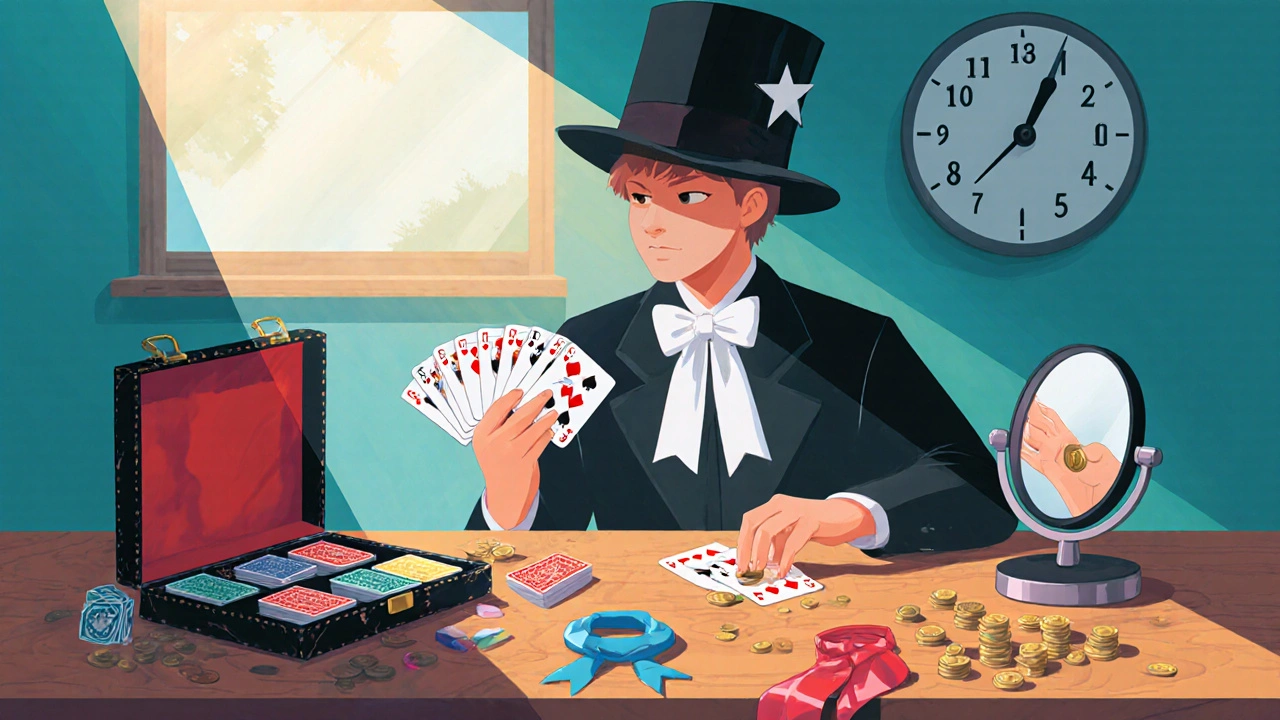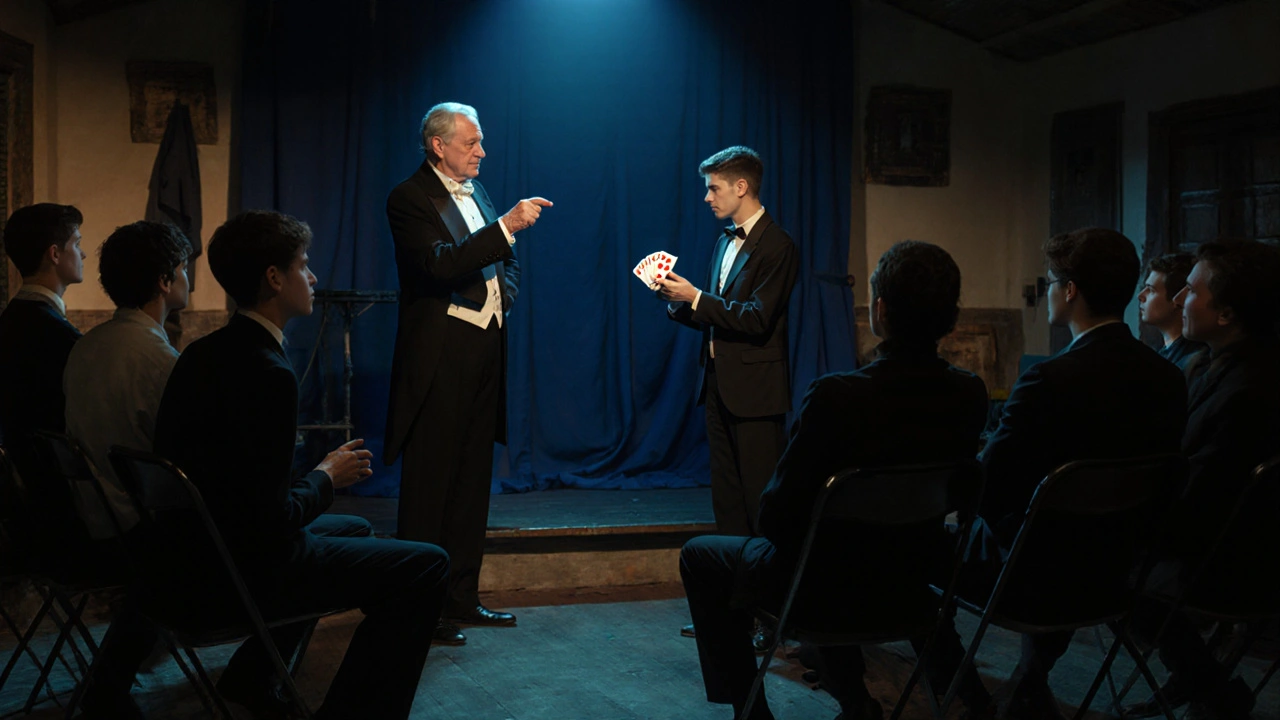Magic Learning Path Advisor
Get personalized recommendations for your magic learning journey based on your goals, budget, and available time.
Recommended Learning Path
Select your goals and budget to see personalized recommendations.
Quick Takeaways
- Start with a focused practice routine that blends theory and hands‑on drills.
- Combine free online tutorials with a starter magic kit for quick wins.
- Join a local magic society or find a mentor to get feedback and keep motivation high.
- Invest in live classes or workshops once you’ve mastered basic sleight of hand.
- Study performance psychology to turn tricks into memorable shows.
Ever watched a magician make a card vanish and thought, "How on earth did they do that?" That spark is the perfect launchpad for learning magic tricks. The journey isn’t about memorizing gimmicks; it’s about building a toolbox of skills, habits, and confidence. Below you’ll find a step‑by‑step roadmap that works for absolute beginners and scales up as you get more comfortable.
Understanding What You’re Trying to Master
Magic tricks are performances that create the illusion of the impossible using misdirection, sleight of hand, and psychological subtleties. They fall into two broad categories: close‑up (cards, coins, everyday objects) and stage (large‑scale effects, lighting, props). Knowing which style excites you most will shape the learning path you choose.
Build a Foundation with sleight of hand
Sleight of hand is the precise, often invisible manipulation of objects that forms the core of most close‑up magic. It’s the muscle memory you develop when you practice a classic two‑card spread or a coin palm. Without solid sleight, even the flashiest gimmick looks sloppy.
Start with these three low‑risk drills:
- One‑handed card fans for 5 minutes each day.
- Coin fingertips lifts while looking at a mirror.
- Basic false shuffle using a single deck.
Consistency beats intensity; five minutes daily beats an hour once a week.
Choose the Right Learning Medium
The internet exploded with free tutorials, but not every video teaches the same skill level or teaching style. Pair each medium with a clear benefit.
| Method | Cost | Interaction Level | Learning Speed | Beginner Friendliness | Typical Time to Competence |
|---|---|---|---|---|---|
| Online tutorials | Free-$30 per subscription | Low (comment sections only) | Fast for visual learners | High (many beginner playlists) | 1-3 months |
| Live classes | $50-$200 per workshop | High (hands‑on feedback) | Medium - guidance speeds up error correction | Medium - instructor sets pace | 2-4 months |
| Books & PDFs | $10-$30 each | Very low | Slow - self‑paced reading | High - detailed explanations | 3-6 months |
| Magic kits | $20-$80 per kit | Medium (includes printed guides) | Fast for specific effects | Very high - kit designed for beginners | 1-2 months |
| Mentorship | Varies - often trade‑for‑practice | Very high (one‑on‑one) | Fast - corrective feedback | Medium - requires commitment | 1-3 months |
For most beginners, a hybrid approach works best: start with free online tutorials to get the basics, then add a starter magic kit that contains the props you’ll practice with.

Get Your Hands on a Starter Magic Kit
Magic kits are pre‑packaged sets that include beginner‑level props, instruction booklets, and often a DVD or QR code to video lessons. They remove the guesswork of “what should I buy?” and let you focus on performance.
When choosing a kit, look for these attributes:
- Clear, high‑resolution photographs of each prop.
- Step‑by‑step written guide plus QR‑linked video.
- At least one close‑up effect (cards or coins) and one stage‑type effect (silk or rope).
Popular beginner kits in 2025 include the “Parker Card Magic Starter” and the “Mystic Coin Collection”. Both cost under $60 and receive positive reviews from the International Brotherhood of Magicians.
Structure Your Practice Routine
Practice routine is a scheduled set of drills and performance rehearsals designed to turn raw skill into fluid execution. Without a routine, practice becomes random and progress stalls.
Here’s a proven 30‑minute daily template:
- Warm‑up (5min): Finger stretches, light card shuffling, coin rolls.
- Skill drill (10min): Pick one sleight (e.g., double lift) and repeat until you can perform it without looking at your hands.
- Effect assembly (10min): Combine the sleight with a simple patter. Record yourself on a phone.
- Review (5min): Watch the recording, note any “tell‑tale” movements, and adjust.
Stick to the template for at least two weeks before swapping in a new sleight. This incremental approach builds muscle memory while keeping motivation high.
Join a Community - Magic Societies and Forums
Learning in isolation makes it easy to plateau. Magic societies are organized groups of magicians who meet regularly for performances, critiques, and workshops. They also host online forums where tricks are discussed and feedback is given.
In the United States, the most active societies include:
- International Brotherhood of Magicians (IBM) - local assemblies in most major cities.
- The Society of American Magicians (SAM) - offers both in‑person meet‑ups and a vibrant Facebook group.
Even if you can’t attend a meeting, joining their forums gives you access to:
- Weekly “trick‑of‑the‑week” challenges.
- Mentor‑matching programs for beginner‑to‑mentor pairings.
- Live‑streamed Q&A sessions with professional magicians.
Study Performance Psychology
Technical skill is only half the battle. Performance psychology deals with the mental aspects of presenting magic, such as confidence, timing, and audience management. A few simple habits can make a decent routine feel spectacular.
- Storytelling: Frame each effect with a short, relatable anecdote. People remember the story, not just the trick.
- Eye contact: Keep your gaze slightly above the audience’s line of sight; it creates the illusion of control.
- Pause for impact: A two‑second pause before the reveal builds tension and magnifies surprise.
Read “The Psychology of Magic” (2023) for deeper insights. Applying these principles early on separates a hobbyist from a performer.

Transition to Live Classes and Mentorship
Once you can reliably execute a handful of effects, it’s time to invest in structured feedback. Live classes offer:
- Real‑time correction of subtle tells.
- Opportunities to practice in front of a live audience.
- Networking with fellow learners.
Mentorship works similarly but with a one‑on‑one focus. Many senior magicians accept apprenticeships in exchange for helping with shows or managing social media.
Tip: When approaching a potential mentor, bring a 2‑minute performance video highlighting your best effect. This shows seriousness and gives them a clear basis for feedback.
Putting It All Together - A Sample 3‑Month Roadmap
- Weeks1‑2: Watch three beginner YouTube playlists (e.g., “Card Basics 2025”). Practice the warm‑up routine daily.
- Weeks3‑4: Purchase a beginner magic kit. Master at least two effects from the kit, recording each practice session.
- Weeks5‑6: Join a local magic society’s online forum. Post your videos for critique; incorporate feedback.
- Weeks7‑8: Add performance psychology: script a short story for each effect and rehearse with pauses.
- Weeks9‑10: Enroll in a weekend live workshop (cost around $120). Focus on polishing misdirection.
- Weeks11‑12: Secure a mentorship relationship; schedule two 30‑minute video calls. Perform a 5‑minute set for friends and gather reactions.
Follow this plan and you’ll have a polished 5‑effect repertoire, a solid practice habit, and the confidence to perform on stage or at a party.
Common Pitfalls and How to Avoid Them
- Skipping the basics: Jumping straight to flashy props without mastering sleight leads to sloppy performances. Stick to core drills for at least a month.
- Over‑reliance on video: Watching tricks is passive. Always replicate the move yourself before moving on.
- Neglecting audience management: Even a perfect trick falls flat if you ignore the crowd’s focus. Practice eye‑contact and timing.
- Practice fatigue: 10‑minute focused sessions beat hour‑long sloppy ones. Use a timer.
FAQs
How much time should I spend practicing each day?
Aim for 20‑30 minutes of focused practice. Consistency beats length; short daily sessions build muscle memory faster than occasional marathon sessions.
Do I need to buy expensive props to start?
No. A well‑chosen beginner magic kit (under $70) provides all the props you need. Upgrade only after you’ve mastered the basics.
Is it better to learn from books or videos?
Start with free videos for visual demonstration, then supplement with a reputable book for deeper theory and detailed explanations. The combination covers both seeing and understanding.
Can I learn magic tricks on my own, or do I need a mentor?
You can start solo using tutorials and kits, but a mentor accelerates progress by catching subtle tells you’ll miss yourself. Consider mentorship after you’re comfortable with basic sleights.
What’s the fastest way to impress friends at a party?
Learn a strong, fast‑to‑perform effect like the “Self‑Working Card Trick” that requires minimal sleight. Pair it with a catchy story and a well‑timed pause for dramatic reveal.
Whether you’re drawn to the glitter of stage illusion or the intimate feel of a card flourish, the path to mastering magic starts with a clear plan, consistent practice, and the right community. Use the steps above, stay curious, and soon you’ll be the one leaving audiences wondering, "How did they do that?"

